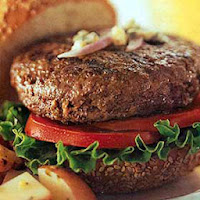 Originally, the Native Plains Indians of North America used just about every part of the bison. Their lives revolved the availability of bison whose original range was from Alaska to Mexico to the Florida panhandle. But by the 1890's this all changed as the bison were being eliminated by European settlers. This occurred for 2 reasons.
Originally, the Native Plains Indians of North America used just about every part of the bison. Their lives revolved the availability of bison whose original range was from Alaska to Mexico to the Florida panhandle. But by the 1890's this all changed as the bison were being eliminated by European settlers. This occurred for 2 reasons.First, there was the greed factor. For a good part of the 1800's bison were considered to be in limitless supply. For non-native buffalo hunters they were the equivalent of a gold mine on 4 legs. This group hunted bison from trains and horseback for their tongues, hides, bones and little else. The tongue was, and still is, considered a delicacy. Hides were prepared and shipped to the east and Europe for processing into leather. Remaining carcasses were, for the most part, left to rot. By the time nothing but bones remained, they too were gathered and shipped via rail to eastern destinations for processing into industrial carbon and fertilizer. By the 1890's with numbers nearing extinction, the bison "gold rush" was over.
At the same time, the American government openly encouraged elimination of the Plains Indians' primary food source, the bison. In so doing, the Indians would be forced into relatively small areas, or north into Canada. In either situation, food sources were either scarce or non-existent. The results were starvation, and high infant mortality amongst the Indian populations. In the end the west was open to European settlement and the start of the western beef industry.
Only in the last 10-15 years can it be said that North American Bison have returned from the near extinction they faced in the 1890's. What was once decimated to less than 2,000 in number has, through careful breeding and and nurturing, returned and flourished.
Today it is estimated that the total herd size is in the 550,000 range, about 275,000 of which are based in Canada. This of course is a far cry from the approximate 50 million animals that roamed the western ranges prior to European settlement. However, today's herd size is still substantial enough to sustain bison meat consumption to a point where it is expected quadruple by this year.
Is it really healthier? The short answer is yes. Buffalo is lower in fat and higher in protein than Beef, Pork or Chicken Breast. But that's not the whole story. In fact, cooking techniques and cut of meat has much to do with it.
The USDA publishes this breakdown:
- Buffalo 100g: Calories = 143, Fat = 2.42g
- Beef 100g: Calories = 211, Fat = 9.28g
- Pork 100g: Calories = 212, Fat = 9.66g
- Chicken Breast (Skinless) 100g: Calories = 177, Fat = 7.70g
How do I cook buffalo? Bison steaks, roasts, stews, burgers and the like, all require slightly different cooking techniques than is the case for beef. Bison's lower fat content is one reason why special cooking considerations have to be made. You can use buffalo in the exact same way however. Cook slower at lower temperatures. Buffalo should not be heated to internal temp higher than 165F. Buffalo is perfect when the center is slightly brown and the juices run clear.
Our Buffalo Burgers are All-Natural. The bison are raised naturally and grass fed without the use of any chemicals, hormones or steroids.

No comments:
Post a Comment